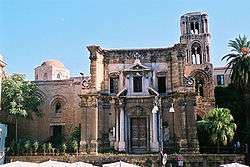Kalsa

Kalsa or Mandamento Tribunali is a historical quarter of the Italian city of Palermo in Sicily.
Names
The common name of the quarter, Kalsa, derives from the district's historic Arabic name, Al-Khalisa, meaning "the purest." The formal name of the quarter, Mandamento Tribunali, meaning "district of courts," derives from the presence of Inquisition courts at the Palazzo Chiaramonte-Steri.
History
Al-Khalisa was centre of the city of Balarm (Palermo) conquered by the Normans during a battle against Arab forces early in 1072. The other district, Al-Kasr (today the Cassaro), took its name from the castle that stood there, though there were several fortified buildings in Al-Khalisa too.
Ibn Jubair visited the area in the end of the 12th century and described (Al-Kasr and Al-Khalisa in Balharm). "The capital is endowed with two gifts, splendor and wealth. It contains all the real and imagined beauty that anyone could wish. Splendor and grace adorn the piazzas and the countryside; the streets and highways are wide, and the eye is dazzled by the beauty of its situation. It is a city full of marvels, with buildings similar to those of Cordoba, built of limestone. A permanent stream of water from four springs runs through the city. There are so many mosques that they are impossible to count. Most of them also serve as schools. The eye is dazzled by all this splendor."
In ancient times, much of what would later become Al-Khalisa was underwater. Stories abound of Hamilcar and Hannibal docking their ships at the Cala (Kala) bay, the ancient city's port, in preparation for attacks on the Greek city of Himera (near Termini Imerese) eastward along the coast. The walls of the Phoenicians' and Carthaginians' older Punic city extended to what was once the confluence of the Papyrus and Kemonia rivers where Al-Khalisa begins (today roughly the intersection of Via Roma and Via Vittorio Emanuele). The centre of Al-Khalisa was located near what is now Piazza Kalsa, though much of the square's present "Arabesque" ambience, such as the "Greek Gate," is due to sixteenth-century revival movements based on Spanish Moorish themes rather than anything we can trace directly to the emirate of Bal'harm. Nevertheless, Al-Khalisa was known for its narrow, winding streets, and some of the existing ones clearly follow eleventh-century patterns. This is one of the features that gives much of Old Palermo its distinctly Arab atmosphere, though this has to do with much more than architecture.
Geography
Kalsa is delimited by:
- Via Maqueda to the west
- Via Lincoln to the south
- Foro Italico to the east
- Via Vittorio Emanuele to the north
Culture

On summer evenings, Kals'art, an arts festival, is held in the streets of Kalsa.
Monuments
|
Chiese
Porte Palazzi |
Teatri
Piazze
|
Fontane
Oratori
Altro
|
External links
Coordinates: 38°06′58″N 13°22′08″E / 38.11611°N 13.36889°E